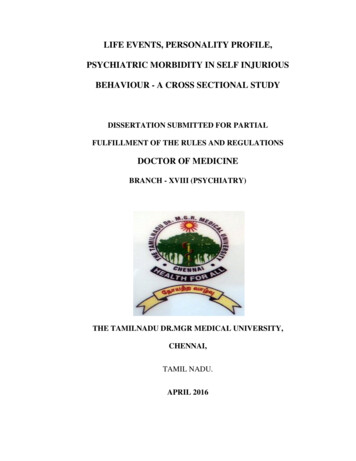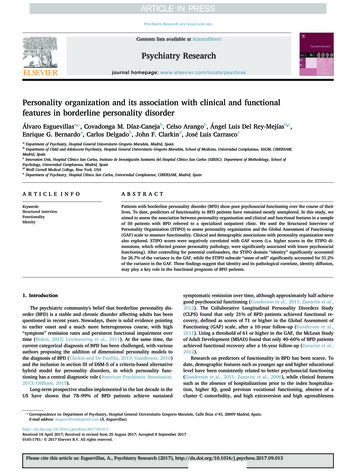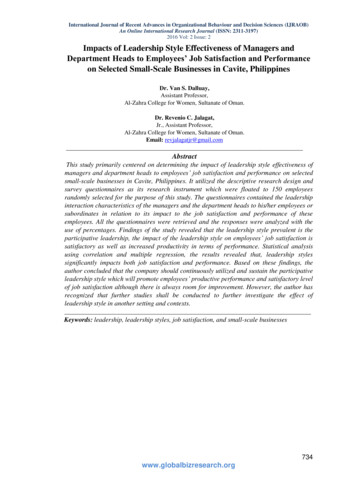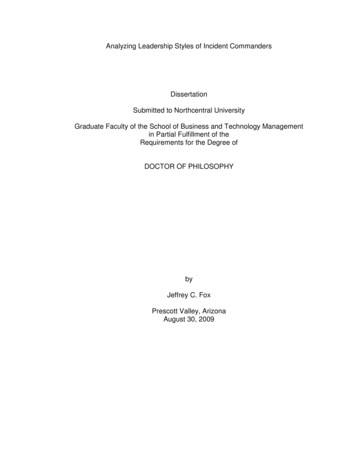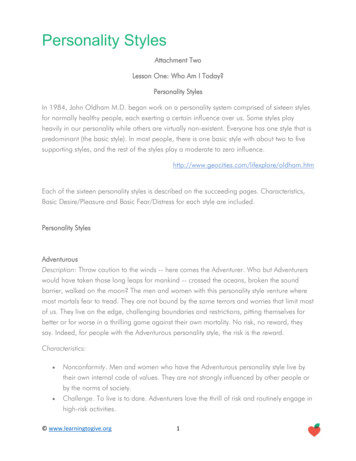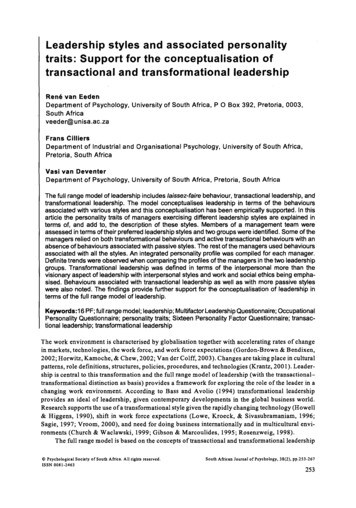
Transcription
Leadership styles and associated personalitytraits: Support for the conceptualisation oftransactional and transformational leadershipRene van EedenDepartment of Psychology, University of South Africa, POBox 392, Pretoria, 0003,South Africaveeder@unisa.ac.zaFrans CilliersDepartment of Industrial and Organisational Psychology, University of South Africa,Pretoria, South AfricaVasi van DeventerDepartment of Psychology, University of South Africa, Pretoria, South AfricaThe full range model of leadership includes laissez-faire behaviour, transactional leadership, andtransformational leadership. The model conceptualises leadership in terms of the behavioursassociated with various styles and this conceptualisation has been empirically supported. In thisarticle the personality traits of managers exercising different leadership styles are explained interms of, and add to, the description of these styles. Members of a management team wereassessed in terms oftheir preferred leadership styles and two groups were identified. Some ofthemanagers relied on both transformational behaviours and active transactional behaviours with anabsence of behaviours associated with passive styles. The rest of the managers used behavioursassociated with all the styles. An integrated personality profile was compiled for each manager.Definite trends were observed when comparing the profiles of the managers in the two leadershipgroups. Transformational leadership was defined in terms of the interpersonal more than thevisionary aspect of leadership with interpersonal styles and work and social ethics being emphasised. Behaviours associated with transactional leadership as well as with more passive styleswere also noted. The findings provide further support for the conceptualisation of leadership interms of the full range model of leadership.Keywords:16 PF; full range model; leadership; MultifactorLeadership Questionnaire;OccupationalPersonality Questionnaire; personality traits; Sixteen Personality Factor Questionnaire; transactional leadership; transformational leadershipThe work environment is characterised by globalisation together with accelerating rates of changein markets, technologies, the work force, and work force expectations (Gordon-Brown & Bendixen,2002; Horwitz, Kamoche, & Chew, 2002; Van der Colff, 2003). Changes are taking place in culturalpatterns, role definitions, structures, policies, procedures, and technologies (Krantz, 200 l). Leadership is central to this transformation and the full range model ofleadership (with the transactionaltransformational distinction as basis) provides a framework for exploring the role of the leader in achanging work environment. According to Bass and Avolio (1994) transformational leadershipprovides an ideal of leadership, given contemporary developments in the global business world.Research supports the use of a transformational style given the rapidly changing technology (Howell& Higgens, 1990), shift in work force expectations (Lowe, Kroeck, & Sivasubramaniam, 1996;Sagie, 1997; Vroom, 2000), and need for doing business internationally and in multicultural environments (Church & Waclawski, 1999; Gibson & Marcoulides, 1995; Rosenzweig, 1998).The full range model is based on the concepts of transactional and transformational leadership c Psychological Society of South Africa. All rights reserved.ISSN 0081-2463South African Journal of Psychology, 38(2), pp.253-267253
Rene van Eeden, Frans Cilliers and Vasi van Deventeras developed by Burns (1978 in Bass, 1997) and expanded by Bass (1985 in Bass, 1997). Accordingto Bass (1997, p. 130) the transactional-transformational distinction views leadership 'as either amatter of contingent reinforcement offollowers by a transactional leader or the moving offollowersbeyond their self-interests for the good of the group, organization, or society by a transformationalleader'. The full range model in addition allows for passive behaviours and it can be regarded as ahybrid explanation (Bass, 1990; Den Hartog, Van Muijen, & Koopman, 1997) incorporating aspectsof various theoretical approaches. However, despite being a relatively comprehensive model, Yukl(1999) contends that some important leadership behaviours have been omitted and that this shouldbe regarded as a weakness of a model referred to as the full range model ofleadership.The full range model includes laissez-faire behaviour, transactional leadership, and transformationalleadership (Bass & Avolio, 1994). The conceptualisation of the leadership styles in themodel is summarised in Table 1. These styles are regarded as separate dimensions and better leadersdisplay each of the three styles to some degree. As mentioned the model represents varioustheoretical approaches but the conceptualisation of these leadership styles primarily in terms of thebehaviours associated with each, links the model to trait theories. Trait theories focus on qualitiesthat differentiate leaders from followers. The current perspective is that traits do not ensureleadership success but that some traits do distinguish effective leaders (Bateman & Snell, 1999). Inresearch as well as practice personality traits are usually operationalised in terms of behaviouralpreferences (or exposed personality traits). It should be noted that in the case of charisma, anessential transformational leadership behaviour (Carless, Wearing, & Mann, 2000), the full rangemodel distinguishes between charismatic behaviour and attributed charisma (Avolio, Bass, & lung,1999'; Conger & Kanungo, 1994; Kanungo & Conger, 1992).Research on the personality traits associated with transactional and transformational leadershipsupports the conceptualisation of the leadership styles in terms of leadership behaviours and thenature ofthe influencing process, the latter consisting of a visionary and an interpersonal component.A focus on organisational change, a greater degree of risk taking, a tendency to be proactive, the useof more planning (futurity), and innovative problem solving characterise the transformational leader(Church & Waclawski, 1998; Howell & Higgens, 1990; Miller, Kets de Vries, & Toulouse, 1982iVan Rensburg & Crous, 2000). This corresponds with the definition of the transformational leaderas being innovative and less likely to support the current situation, seeking opportunities in the faceof risk, and attempting to shape and create rather than react to environmental circumstances (Loweet a/., 1996). However, Ross and Offermann (1997) did not find a need for change to be a significantpredictor oftransformational leadership. Interpersonal factors explained most ofthe variance in theirstudy. Articulating a vision was found to be another distinguishing characteristic oftransformationalleadership, especially as a means for inspiring others (Church & Waclawski, 1998; Hogan, 1994;Howell & Higgens, 1990; Wofford, Goodwin, & Whittington, 1998). The setting oflong-term goalsreflects the need for achievement referred to by Howell and Higgens (1990) and Van Rensburg andCrous (2000).Ho gan (1994) emphasises social and interpersonal skills as present in transformational leaders.These skills are reflected in personality traits such as adjustment (e.g., being self-confident and ableto handle pressure), social impact (e.g., being outgoing and assertive), and agreeableness (e.g., beingwarm and friendly). Ross and Offermann (1997) found support for the presence of self-confidenceand Van Rensburg and Crous (2000) found that transformational leaders showed a need foraffiliation and that their interpersonal relationships were warm, accepting, and supportive while theyalso showed an enjoyment of attention from others. Ross and Offermann (1997) found personalityattributes associated with the functions of intellectual stimulation and individualised considerationto be the more consistent predictors oftransformational leadership. A factor representing an enablingstyle of leadership characterised by practical support and concern for subordinate developmentexplained most of the variance in their study.254
Leadership styles and associated personality traitsTable 1. Conceptualisation of the leadership styles in the full range modelTransformational leadershipIdealised influence implies that followers respect, admire, and trust the leader and emulate his or herbehaviour, assume his or her values, and are committed to achieving his or her vision and makingsacrifices in this regard. The leader shows dedication, a strong sense of purpose and perseverance, andconfidence in the purpose and the actions of the group that helps to ensure the success of the group andgives followers a sense of empowerment and ownership. He or she behaves morally and ethically.Inspirational motivation refers to the leader(s enthusiasm and optimism in creating a vision of thefuture, thus stimulating similar feelings with followers. The leader is seen to commit to the vision,specific goals and expectations are clearly communicated, and confidence is expressed in followers'ability to achieve these expectations.Intellectual stimulation implies a leader who values the intellectual ability of followers and whoencourages innovation and develops creativity. Others are encouraged to reframe problems, use aholistic perspective in understanding problems, question the status quo, and approach problems fromdifferent angles, thus creating readiness for change and developing the ability to solve current and futureproblems.Individualised consideration implies that the leader considers the ability of followers and their level ofmaturity to determine their need for further development. He or she acts as a mentor giving personalattention, listening to others' concerns, and providing feedback, advice, support, and encouragement.The leader furthermore designs appropriate strategies to develop individual followers to achieve higherlevels of motivation, potential, and performance. Support is provided and progress monitored.Transactional leadershipTransactional leadership involves a social exchange process where the leader clarifies what thefollowers need to do as their part of a transaction (successfully complete the task) to receive a reward oravoidance ofpunishment (satisfaction of the followers' needs) that is contingent on the fulfilment of thetransaction (satisfying the leader's needs).In the case of active management by exception, the leader looks for mistakes, irregularities, exceptions,deviations from standards, complaints, infractions of rules and regulations, and failures and he or shetakes corrective action before or when these occur. Passive management by exception implies that theleader is reactive and waits to be informed about errors and deviances before taking action.Laissez-faire style or passive leadershipThis style implies avoidance or absence ofleadership. The leader leaves responsibility for the work tofollowers and avoids setting goals and clarifying expectations, organising priorities, becoming involvedwhen important issues arise, taking a stand on issues and making decisions. If this style is used as acomponent of other leadership styles it allows for the possibility of self-management.Based on Bass (1990,1997) and Bass and Avolio (1994, 1995)The present discussion contributes to the personality-leadership literature by using holisticprofiles of individuals as the source of information rather than following the example of prior workand comparing groups that differ in leadership style in terms of their mean performance on separatepersonality traits. Mean scores could obscure the variation between members of a group as well asthe preferences ofthe maj ority versus the exceptions. The same result on a specific trait, furthermore,has different interpretations depending on the way in which it is combined with other traits. Inpractice, the evaluation for placement and development of individuals in leadership positionsincludes an integrated personality profile that considers performance on all related traits. It wasexpected that the use of integrated profiles would add to the understanding of the full range modelin terms of the personality traits associated with the leadership styles defined in this model.255
Rene van Eeden, Frans Gil/iers and Vasi van DevenferMETHODAn intervention was conducted at management level at one of the plants of a South African production company that had been engaged in a process of transformation. In response to continuouschanges in technology and customer demands, the organisation had been adapting at operationallevel and in terms of the composition and structuring of personnel. One of the aspects that had to beaddressed was perceived differences in management styles between members of the managementteam and the impact thereof. Members of the management team were to be sensitised in terms ofindividual and group functioning, and assessment of and feedback on leadership styles and personality characteristics formed part of this process.DesignThe intervention focused on the above mentioned management team and questionnaires wereadministered to assess the leadership styles and personality traits of the members of the team. Foreach manager preferences in terms of leadership behaviours were identified and an integratedpersonality profile was drawn up. The intervention required individual feedback as well as feedbackon the functioning of the group. It is the latter that forms the basis of the present discussion on thepersonality traits associated with different leadership styles. Although the use of the questionnairesimply numerical data and predetermined categories, this information was used to provide qualitativedescriptions firstly at an individual and then at a group level. An integrated personality profileimplies that performance on related traits is considered to describe functioning on a specific aspect(e.g., interpersonal confidence). The conclusion regarding such an aspect might be similar for individuals with different scores on the relevant traits. Trends, that would probably not have emergedin a quantitative analysis, can thus be identified at a group level. Based on leadership preferencesthe team could furthermore be divided into two groups. This made it possible to observe differencesin personality between a group ofmore effective (or more transformational) managers and managerswho could be regarded as less effective in terms of the leadership theory. Despite the small samplethe qualitative nature of the interpretation made it possible to identify clear trends.SampleThe management team consisted of a general manager, a technical expert, managers for the twophases of production, and managers for planning and logistics, quality control, engineering, humanresources, finances, and marketing. Assessment results were available for eight of these managers.The members of the management team were primarily white, Afrikaans-speaking males. Tenurevaried, with some of them having been with the company only a few years and others for more than10 years. Based on a confidentiality agreement, details of the primary task of the company andbiographical information on individual respondents cannot be given. The holistic approach to interpretation would only be possible with a small sample and the focus on the personality-leadershiprelationship provides some justification for the relative homogeneity of the group in terms of demographic variables. Admittedly these aspects limit the generalisability of the findings.Measuring instrumentsThe Multifactor Leadership Questionnaire Form 5X (MLQ 5X), the Occupational PersonalityQuestionnaire version 32 (OPQ32), and the Sixteen Personality Factor Questionnaire, SA 1992version (16PF, SA92) were used. The different versions of the latter questionnaires are regularlyused for personality assessment in the South African context. The OPQ focuses on the workplacewhereas the 16PF measures somewhat different traits in a number of contexts. The traits measuredby these questionnaires correspond with those identified in earlier research on personality characteristics associated with the leadership styles of the full range model.256
Leadership styles and associated personality traitsThe MLQ 5X consists of 36 items that measure transformational leadership, transactionalleadership, and laissez-faire leadership (Bass & Avolio, 1995). The remaining nine items measureoutcomes of leadership. Each of the 45 items contributes to only one factor and the score for thatfactor is the average ofthe relevant items. Each manager completes a self-assessment form on whichhe or she has to rate how often the leadership behaviour in each statement is practised on a rangefrom 0 (not at all) to 4 (frequently, if not always). A rater form containing similar statements iscompleted by a superior, a peer, and subordinates indicating how often the behaviour is observedin the case of the manager. An effective leader is expected to obtain a rating 00 (fairly often) onaverage for transformational leadership as well as on each of the five scales, a rating of 2 (sometimes) for contingent reward, between 1 (once in a while) and 2 (sometimes) for active managementby exception, and between 0 (not at all) and 1 (once in awhile) for passive management by exceptionand laissez-faire behaviour. Support for the reliability and validity of the questionnaire has beenbased on a database consisting of 14 separate studies (Avolio et al., 1999). The Western capitalistculture ofthe management team included in the present study made the questionnaire suitable despitecomparatively limited research in the South African context.The OPQ32 is an updated version ofthe original OPQ Concept Model developed between 1981and 1984 in the UK (SHL, 1999). The normative version used in this study consists of 230 statements; respondents are asked to rate each statement on a scale ranging from strongly disagree (1) tostrongly agree (5). Raw scores are transformed into scores on a sten scale for each of the 32dimensions (the norms for a UK general population sample were used). The sten scores areinterpreted in terms of the description on each bipolar scale of a low score, an average score, and ahigh score. The mean of 5.5 and standard deviation of 2 are considered in determining thesecategories. The 32 dimensions measured by the OPQ32 are grouped into four domains, namely,relationships with people, thinking style, feelings and emotions, and dynamism. A score on a SocialDesirability scale is also obtained. Acceptable results in terms of the internal consistency reliabilityand the validity of the questionnaire is reported in the manual (SHL, 1999) and elsewhere (Barrett,Kline, Paltiel, & Eysenck, 1996; Matthews & Stanton, 1994; Robertson & Kinder, 1993). Swanevelder (2003) focused specifically on the usefulness ofthe questionnaire in the South African contextand reports structural equivalence for black and white subgroups.Prinsloo (1992) describes the development of the 16PF (SA92). The SA92 version consists of160 items/questions; each item consists of a statement with three response options scored as 0, 1, or2. The items are combined into 16 bipolar scales. Raw scores are transformed to a sten scale witha mean of 5.5 and a standard deviation of 2. Norms are available for the total group and for malesand females separately (the latter tables were used in this study). The sten scores are interpreted interms of the description on each bipolar scale of a low score (range of 1 to 3), an average score(range of 4 to 7), and a high score (range of 8 to 10). The items are combined into 16 primarypersonality traits (Russell & Karol, 1994) that in turn are combined in groups to obtain scores on thesecondorder factors Extroversion, Anxiety, Emotional Sensitivity (Tough Poise), Independence, andCompulsivity (Prinsloo, 1992). A score is also obtained on the Motivational Distortion Scale (MDScale). Reliability coefficients, the results offactor analyses, and subgroup comparisons are reportedin the manual. According to Prinsloo (1992, p. 26) ' . the questionnaire measures the same constructs, structured in the same way, in a reliable, valid and unbiased fashion among testees from anyrelevant sub group' .ProcedureThe human resources manager arranged a session with the management team during which therationale ofthe administration was explained and the personality questionnaires were completed. Themanager who was qualified to do so conducted the administration. The leadership questionnaire257
Rene van Eeden, Frans Cil/iers and Vasi van Deventerimplies self-rating and ratings by others, and the questionnaires were distributed with instructionsfor completion to the relevant individuals. Paper-and-pencil versions ofthe questionnaires were used,and all the questionnaires were completed in English. The researcher provided guidelines for thehuman resources manager and also did the scoring and interpretation and gave individual and groupfeedback. Confidentiality was emphasised.InterpretationThe members of the management team were evaluated in terms of their preferred leadership stylesbased on the ratings by others (superiors, peers, and subordinates). The average ratings for themanagers in each of the groups are reported in Table 2. The four managers in the first group reliedon both transformational and .active transactional behaviours with an absence of behavioursassociated with the passive styles. The average for transformational leadership as well as the ratingsfor four of the five scales (and the fifth in the case oftwo of the managers) indicated that they usedthe associated behaviours 'fairly often' (a rating of 3). All four managers used active transactionalleadership (contingent reward and active management by exception) to the same extent as transformational leadership. Passive management by exception and laissez-faire leadership were used'once in a while' or 'not at all' (ratings of 1 and 0, respectively). This group would be referred to asthe transformational group although it should be kept in mind that their reliance on active transactionalleadership is higher than expected for effective leadership. The four managers in the secondgroup used behaviours associated with all the styles. With only a few exceptions, the ratings indicated that they 'sometimes' (a rating of2) used the various styles, implying most effective use onlyof active transactional leadership.Table 2. Average ratings for the managers of the two groupsGroup 1Leadership preferencesTransformational leadershipIdealised AttributesIdealised BehavioursInspirational MotivationIntellectual StimulationIndividualised ConsiderationAverageTransactional leadershipContingent -exception(passive)Laissez-faireNote:Group 222232222333333222223222022222202* Average ratings have been roundedBased on the OPQ and l6PF results, an integrated personality profile was developed for eachof the managers. The manager was described in terms of the traits and behaviours associated withthree broad categories, namely, thinking styles and problem-solving patterns, general adjustment,and' relationships and interpersonal styles. It is standard practice to use these categories in theinterpretation ofboth the questionnaires. Trends in terms ofthe traits and behaviours in each ofthesecategories were identified in each ofthe leadership groups and compared across the two groups. The258
Leadership styles and associated personality traitscriteria used were those identified in the section on the measuring instruments, and depending onlow, average, or high scores as well as the combination of scores it was determined if the managersin a group showed patterns of behaviour (with or without exceptions) and how this compared acrossthe two groups.The first category deals with the individual's cognitive style and approaches to problem-solvingas well as the manner in which he or she deals with obligations. Conceptual thinking and creativityare evaluated together with the person's reality-orientation, planning and organising abilities, andsense ofresponsibility. The OPQ dimensions associated with the domain ofThinking Style (groupedas analysis, creativity and change, and structure) are considered together with the 16PF primaryfactors that form part of the second-order factors Tough Poise and Compulsivity as well as theprimary factors Reasoning, Openness to Change, and Self-reliance. Details on the scales associatedwith this category are presented in Table 3.Table 3. The OPQ and 16PF scales associated with thinking styles and problem-solving patternsOPQThinking StyleAnalysisData RationalEvaluativeBehaviouralCreativity and changeConventionalConceptualInnovativeVariety SeekingAdaptableStructureForward ThinkingDetail ConsciousConscientiousRule Following16PFTough ningOpenness to ChangeSelf-relianceThe second category deals with the individual's emotional adjustment and resilience as well ashis or her energy and achievement-orientation. Information based on the dimensions of the domainFeelings and Emotions (grouped as emotion and dynamism) are used together with the 16PF primaryfactors associated with the second-order factor Anxiety. Detail on the scales associated with thiscategory are presented in Table 4.The third category deals with the extent to which the individual enjoys social interaction andwhat role he or she plays in such interaction, how comfortable and competent he or she is in socialsituations, and the person's approach in terms of decision-making and taking the lead. In the caseof the OPQ the dimensions of the domain Relationships with People (grouped as influence,sociability, and empathy) and the dimensions Variety Seeking and Adaptable are considered. Thelatter is interpreted together with results on the l6PF second-order factor Extraversion, the relatedprimary factors, and the primary factors Vigilance and Privateness. Detail on the scales associatedwith this category are presented in Table 5.259
Rene van Eeden, Frans Gilliers and Vasi van DeventerTable 4. The OPQ and l6PF scales associated with general adjustmentOPQFeelings and EmotionsEmotionRelaxedWorryingTough MindedOptimisticTrustingEmotionally sive16PFAnxietyEmotional Table 5. The OPQ and 16PF scales associated with relationships and interpersonal stylesOPQRelationships with endent MindedSociabilityOutgoingAffiliativeSocially ConfidentEmpathyModestDemocraticCaringOtherVariety elinessSocial ERSHIP STYLES AND ASSOCIATED PERSONALITY TRAITSExpectations based on the conceptualisation of and research on the leadership styles as defined inthe full range model are described. The trends identified in each group in the present study as wellas the differences across the two groups are then presented.Thinking styles and problem-solving patternsNumerous authors refer to innovativeness and entrepreneurial qualities that lead to change, as personality characteristics of the effective leader (e.g. Bass, 1990; Bass & Avolio, 1994, 1995; Church& Waclawski, 1998; Hogan, 1994; Howell & Higgens, 1990; Miller et al., 1982; Van Rensburg &Crous, 2000; Wofford et aI., 1998). Inspirational motivation implies a vision for the future that is260
Leadership sty/es and associated personality traitsdifferent and challenging. This requires someone with a strategic approach and a willingness toexperiment and implement change. A holistic perspective, an interest in conceptual thinking, acreative approach as well as a willingness to question assumptions, are also requirements for thefunction of intellectual stimulation (see Table 1).It was expected that the above traits would be more prominent in the case of the transformational group in the present study. However, a clear distinction could not be made between the twogroups in terms of conceptual and creative thinking. The results for the managers in both groupsranged from a focus on practical concerns to a high interest in conceptual thinking, innovation, andthe critical evaluation of information.Adherence to moral standards and rules furthermore reflects the ethical stance associated witha leader who exhibits idealised behaviour and also provides associates with values with which theycan identify (Bass, 1990). A sense of responsibility also reflects the dedication that inspires associates to share the leader's vision and goals. Clarity in terms of goals and the roles of associates inachieving them are requirements for both inspirational motivation and idealised behaviours. However, a preference for the structure provided by guidelines and adherence to regulations are alsorelated to a contingent reward strategy and the use of active management by exception. Variousauthors (Bass, 1997; Hogan, 1994; Miller et al., 1982) refer to the transactional leader's focus ontask performance and use of procedures to maintain control.These patterns were observed in the present study and as this is one of the aspects where a cleardistinction could be made between the two groups, detail is provided in Tables 6 and 7 to illustratethe interpretation process. With one exception, the managers exercising a transformational styleindicated adherence to moral standards and rules and a sense of responsibility in both work andsocial contexts. All the managers in this group furthermore showed adherence to regulations in thework context implying a degree of rigidity. These traits reflected the managers' reliance on bothtransformational and active transactional behaviours. The managers in the second group eithershow
individual and group functioning, and assessment ofand feedback on leadership styles and per sonality characteristics formed part ofthis process. Design The intervention focused on the above mentioned management team and questionnaires were administered to assess the leadership styles and personality traits ofthe members ofthe team. For
